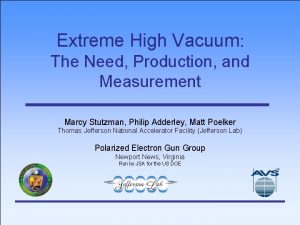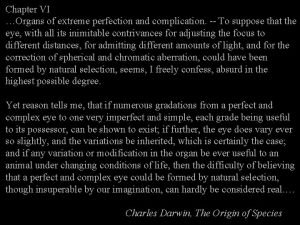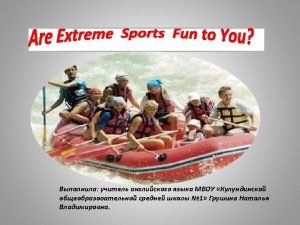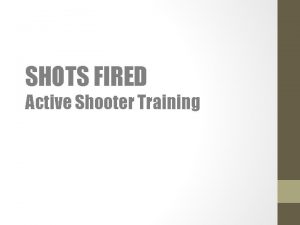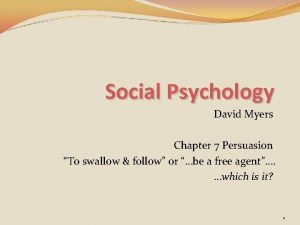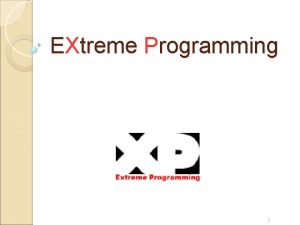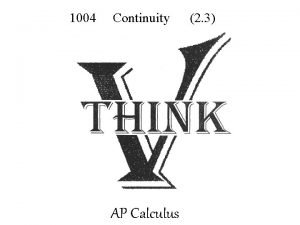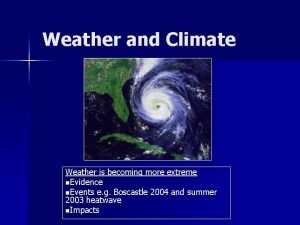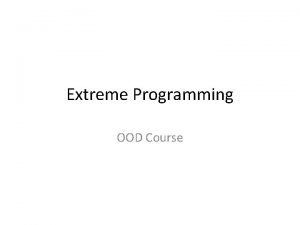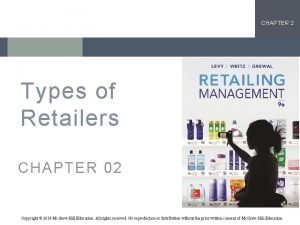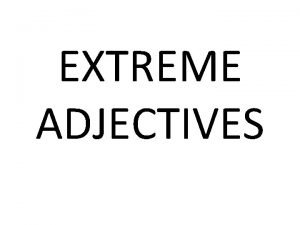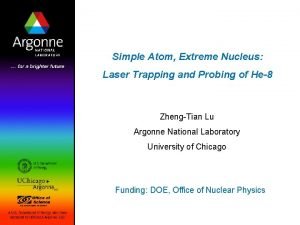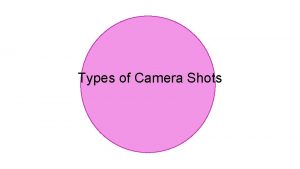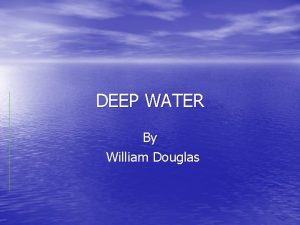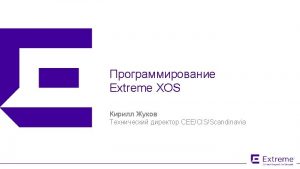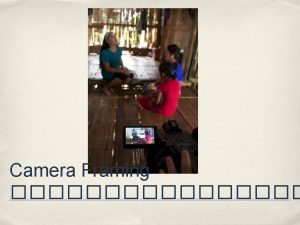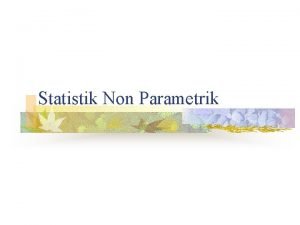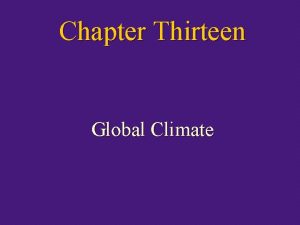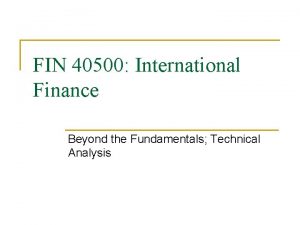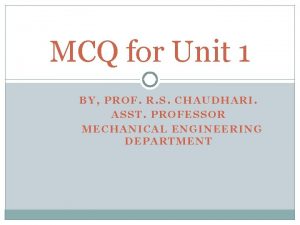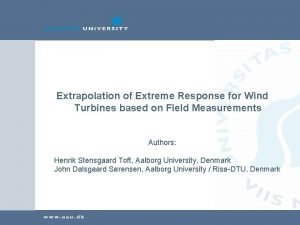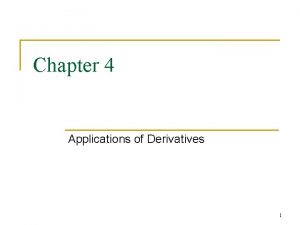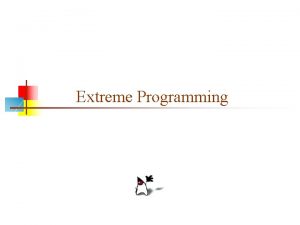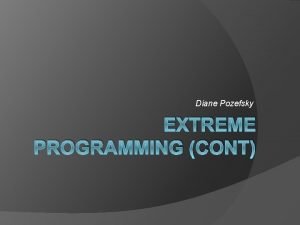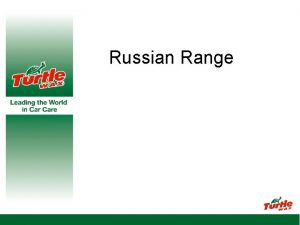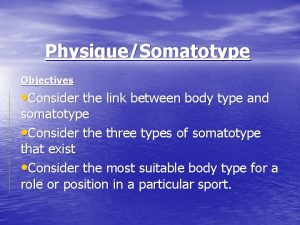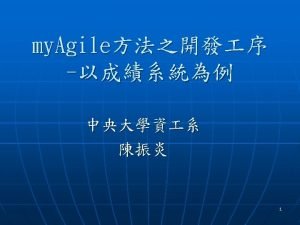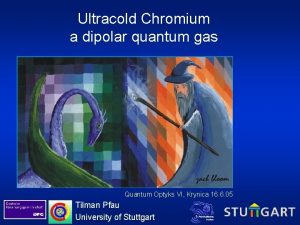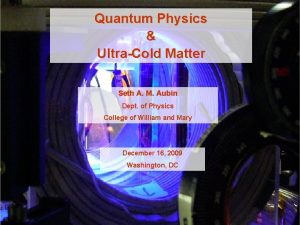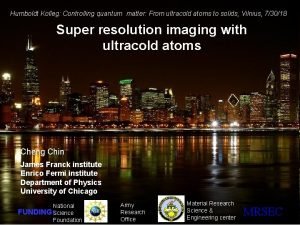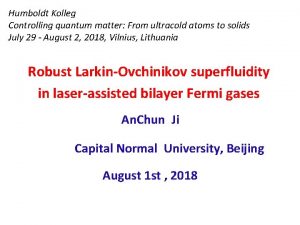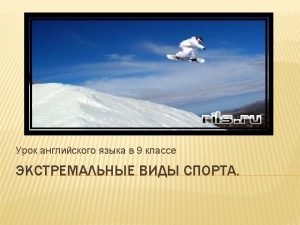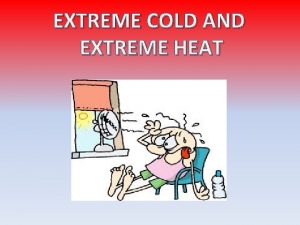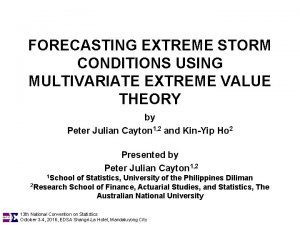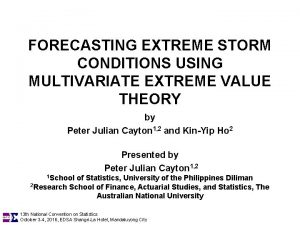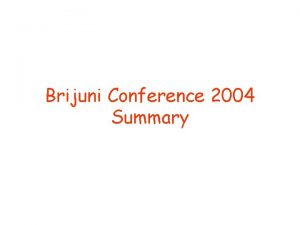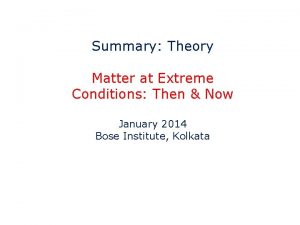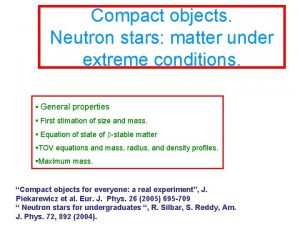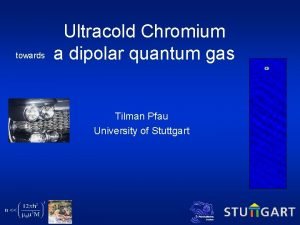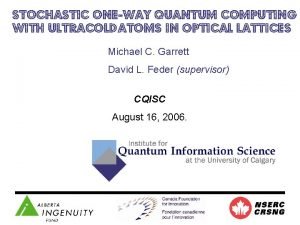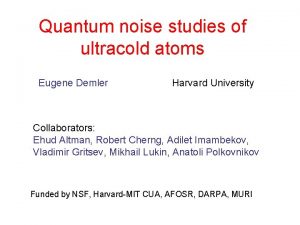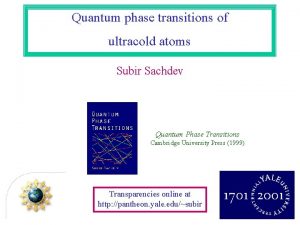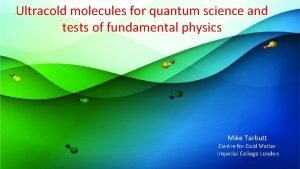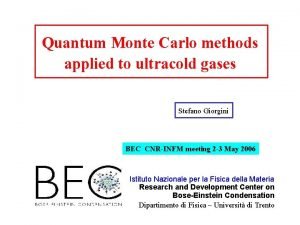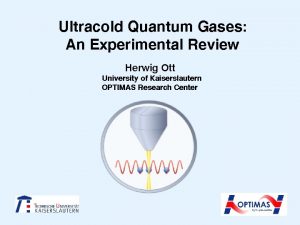Modeling quantum matter at extreme conditions with ultracold

































































- Slides: 65

Modeling quantum matter at extreme conditions with ultracold atoms and QFT methods Vladimir S. Melezhik Bogoliubov Laboratory of Theoretical Physics JINR, Dubna MQFT 2018, Peterhof, 27 September 2018

Outline • Quantum simulations: why cold atoms ? • Examples of modeling quantum matter at extreme conditions • Theoretical modeling of low-dimenional systems • Two-center problem in confining trap in pseudopotential approach • Efficient approach for nonlinear Schrödinger equation • Conclusion

Quantum simulations: why cold atoms ? R. Feynman’s vision: a quantum simulator to study the quantum dynamics of another system R. Feynman, Int. J. Theor. Phys. 21, 467 (1982) Y. Manin, Computable and Uncomputable (Sovetskoye Radio Press, Moscow) (in Russian) 1980. development of physics of ultracold atoms has opened unique possibility for realisation of R. Feynman’s idea: to use simple quantum systems with desiered properties (amenable quantitative description and modeling) to describe more complex systems and phenomena

Quantum simulations: why cold atoms ? Quantum simulation with fully controlled systems control over: particle number quantum state interaction • attractive interactions BCS-like pairing in finite systems • repulsive int. +splitting of trap entangled pairs of atoms (quantum information processing) • + periodic potential quantum many-body physics (systems with low entropy to explore Bose-Hubbard such. Physics as quantum magnetism) • . . .

Quantum simulations: why cold atoms ? control over: particle number

Quantum simulations: why cold atoms ? control over: particle number

Quantum simulations: why cold atoms ? control over: particle number 1/e-lifetime: 250 s Exposure time 0. 5 s CCD distance between 2 neighbouring atom peaks: ~ 6 s 1 -10 atoms can be distiguished with high fidelity > 99%

Quantum simulations: why cold atoms ? control over: particle number • 2 -component mixture in reservoir T=250 n. K • superimpose microtrap • switch off reservoir p 0= 0. 9999 + magnetic field gradient in axial direction

Quantum simulations: why cold atoms ? control over: particle number with high fidelity

Quantum simulations: why cold atoms ? control over: interaction

Quantum simulations: why cold atoms ? control over: interaction

Quantum simulations: why cold atoms ? control over: interaction 3 D Feshbach resonance single-channel pseudopotential strong confinement 1 D Confinement induced resonance (CIR) single-channel pseudopotential with renormalized interaction constant M. Olshanii, PRL 81, 938 (1998).

Quantum simulations: why cold atoms ? control over: interaction 3 D Feshbach resonance single-channel pseudopotential strong confinement 1 D Confinement induced resonance (CIR) single-channel pseudopotential with renormalized interaction constant M. Olshanii, PRL 81, 938 (1998).

Quantum simulations: why cold atoms ? control over: interaction 3 D Feshbach resonance single-channel pseudopotential strong confinement 1 D Confinement induced resonance (CIR) single-channel pseudopotential with renormalized interaction constant M. Olshanii, PRL 81, 938 (1998).

Quantum simulations: why cold atoms ? control over: quantum state 2 R r = 2 R in 1 D: analytic solution for energy: T. Busch et al. , Found Phys Vol. 28, No. 4 549 -559 (1998) same r same energy M. D. Girardeau, PRA 82, 011607(R) (2010)

Quantum simulations: why cold atoms ? control over: quantum state 2 distinguishable fermions 2 identical fermions F. Serwane et al. Science 332(2011)336

Quantum Degenerate Atomic Gases: BEC, Fermions

Solid state physics: modeling phase-transitions

Solid state physics: modeling phase-transitions

BCS-BEC crossover in ultracold Fermi gas

BCS-BEC crossover in ultracold Fermi gas diffusion Monte-Carlo simulation S. Pilati & S. Giorgini PRL 100 (2008) 030401 experiment N. Navon et al Science 328 (2010) 729

BCS-BEC crossover in ultracold Fermi gas diffusion Monte-Carlo simulation S. Pilati & S. Giorgini PRL 100 (2008) 030401 experiment N. Navon et al Science 328 (2010) 729

BCS-BEC crossover in ultracold Fermi gas diffusion Monte-Carlo simulation S. Pilati & S. Giorgini PRL 100 (2008) 030401 experiment N. Navon et al Science 328 (2010) 729

BCS-BEC crossover in ultracold Fermi gas diffusion Monte-Carlo simulation S. Pilati & S. Giorgini PRL 100 (2008) 030401 experiment N. Navon et al Science 328 (2010) 729

Simulations with degenerate quantum gases Gross-Pitaevski equation Bose-Einstein condensation degenarate quantum gases

Modeling quark-gluon plasma, string theory Optically-trapped, strongly-interacting atomic Fermi gases provide a unique possibility for modeling nonperturbative many-body systems and theories. Particularly quark-gluon plasma, string theory a highly-degenerate Fermi gas of = shear viscosity/ entropy density A. Turlapov, J. Kinast, B. Clancy, L. Luo, J. Joseph, J. E. Thomas, J Low Temp Phys 150 (2008) 567

Why it is interesting (theoretical aspects) 3 D free-space theory is no longer valid and development of low-dimensional theory including influence of the trap is needed even two-body problem in low dimensions demans development of special computational techniques

Atom-atom CIRs S. Saeidian & V. Melezhik, Phys. Rev. E 96, 053302(2017)

Atom-atom CIRs S. Saeidian & V. Melezhik, Phys. Rev. E 96, 053302(2017) x z y

Confinement-induced resonances (exp. and theor. ) Sh. Saeidian, V. S. Melezhik , and P. Schmelcher, Phys. Rev. A 86, 062713 (2012) d-wave FR at 47. 8 G develops in waveguide as depending on minimums and stable maximum of transmission coefficient T

Confinement-induced resonances (exp. and theor. ) Sh. Saeidian, V. S. Melezhik , and P. Schmelcher, Phys. Rev. A 86, 062713 (2012) d-wave FR at 47. 8 G develops in waveguide as depending on minimums and stable maximum of transmission coefficient T experiment

Confinement-induced resonances (exp. and theor. ) Sh. Saeidian, V. S. Melezhik , and P. Schmelcher, Phys. Rev. A 86, 062713 (2012) d-wave FR at 47. 8 G develops in waveguide as depending on minimums and stable maximum of transmission coefficient T experiment theory

Confinement-induced resonances (exp. and theor. ) Sh. Saeidian, V. S. Melezhik , and P. Schmelcher, Phys. Rev. A 86, 062713 (2012) d-wave FR at 47. 8 G develops in waveguide as depending on minimums and stable maximum of transmission coefficient T experiment theory single-channel pseudopotential with renormalized interaction constant M. Olshanii, PRL 81, 938 (1998).

Quasi 1 D system with contact interaction M. Olshanii, PRL 81, 938 (1998). T. Bergeman et al. , PRL 91, 163201 (2003). 1 D coupling constant close to 1 z confinement induced resonance Hamiltonian: relative coordinates linear approximation longitudinal transversal repulsive attractive

Confinement induced resonance M. Olshanii, PRL 81, 938 (1998). T. Bergeman et al. , PRL 91, 163201 (2003). • asymptotic boundary conditions • virtual transition to z What is causing the confinement induced resonance (CIR)? excited states

Confinement induced resonance M. Olshanii, PRL 81, 938 (1998). T. Bergeman et al. , PRL 91, 163201 (2003). • asymptotic boundary conditions • virtual transition to z excited states 3 D FBR What is causing the 3 confinement induced 2 resonance (CIR)? 1 0 3 universal 3 D bound state repulsive 0 attractive inverse scattering length - 1/a 3 D

Confinement induced resonance M. Olshanii, PRL 81, 938 (1998). T. Bergeman et al. , PRL 91, 163201 (2003). • asymptotic boundary conditions • virtual transition to z excited states 3 D FBR What is causing the 3 confinement induced 2 resonance (CIR)? 1 shifted zero energy 0 3 repulsive “confinement induced molecules” H. Moritz et al. , PRL 94, 210401 (2005) 0 attractive inverse scattering length - 1/a 3 D

Confinement induced resonance M. Olshanii, PRL 81, 938 (1998). T. Bergeman et al. , PRL 91, 163201 (2003). • asymptotic boundary conditions • virtual transition to z excited states 3 D FBR What is causing the 3 confinement induced 2 resonance (CIR)? 1 2 nd excited level CIR 0 3 atoms couple to a transversally excited bound state repulsive 0 attractive inverse scattering length - 1/a 3 D

Mean-field formalism with contact interactions has been shown to provide a powerful tool for analyzing the properties of trapped Bose gases F. Dalfano, S. Giorgini, L. P. Pitaevski, S. Stringari, RMP 71, 463 (1999) I. Bloch, J. Dalibard, W. Zwerger, RMP 80, 885, (2008) I. Bloch et al. Nature (2012) J. Dalibard et al. RMP (2011) …

Hybrid systems ``atom+ion‘‘ quantum simulation with cold atoms and ions other proposals: formation of molecular ions, polarons, density bubbles, collective excitations, quantum information processing (two-qubit gate), mesoscopic entanglement …

Two-center Problem of Quantum Mechanics

Physics of ultracold quantum gases: two-center problem in confined geometry of atomic and hybrid atom-ion traps CIR (? )

Physics of ultracold quantum gases: two-center problem in confined geometry of atomic and hybrid atom-ion traps CIR (? ) in perspective: N-center problem in confining trap

Two-center Problem in Waveguide-like Trap in Pseudopotential Approach S. Shadmehri and V. Melezhik (2018) (submitted) natural generalization: (? )

Two-center Problem in Waveguide-like Trap in Pseudopotential Approach

Two-center Problem in Waveguide-like Trap in Pseudopotential Approach 1/d ∞

Two-center Problem in Waveguide-like Trap in Pseudopotential Approach S. Shadmehri and V. Melezhik (2018) (submitted) alternative regularization removes the difficulty at α --> 0

Two-center Problem in Waveguide-like Trap in Pseudopotential Approach S. Shadmehri and V. Melezhik (2018) (submitted)

Two-center Problem in Waveguide-like Trap in Pseudopotential Approach S. Shadmehri and V. Melezhik (2018) (submitted) M. Olshanii, PRL 81, 938 (1998). (single scatterer) 0

Two-center Problem in Waveguide-like Trap in Pseudopotential Approach S. Shadmehri and V. Melezhik (2018) (submitted) Two CIRs (? ) α 0

Two-center Problem in Waveguide-like Trap in Pseudopotential Approach (CIRs) S. Shadmehri and V. Melezhik (2018) (submitted) : one-center CIR ->

Two-center Problem in Waveguide-like Trap in Pseudopotential Approach (CIRs) S. Shadmehri and V. Melezhik (2018) (submitted) “platform” for low-dimansional and 3 D effective field theories (N particles)

3 D non-linear Schrödinger eq. (effective mean field with contact interaction) Gross-Pitaevski equation Bose-Einstein condensation degenarate quantum gases

economic computational scheme V. Melezhik EPJ Web of Conf. 173, 01008 (2018) BLTP JINR two-core Intel processor Xenon 5160 with 3 GHz frequency

3 D non-linear Schrödinger eq. (effective mean field with contact interaction) Bose-Einstein condensation degenarate quantum gases tunnebility over g 2 |ψ(z, ρ=0, t)| g=-200 g=+240 z t

Conclusion • physics of ultracold atoms (and recently iones) quantum simulation with fully controlled systems • 3 D free-space theory is no longer valid and development of low-dimensional theory including influence of trap is needed • it stimulates development of low-dimensional few- and many-body theoretical models • particularly, it was shown: mean field models with contact interactions provide powerful tool for analyzing trapped ultracold quantum gases • results and developed computational techniques can potentially be used in free-space models as well as in low-dimensional systems

CONCLUSION

Outlook, goals and opportunities Quantum simulation with fully controlled systems control over: particle number, quantum states, interaction Fast-growing field, promising applications in study of many problems I. M. Georgescu et al. Quantum simulations, Rev. Mod. Phys. 86 (2014) 153 J. I. Cirac and P. Zoller, Goals and opportunities in quantum simulation, Nature Phys. 8 (2012) 264 M. Dalmonte and S. Montangero, Lattice gauge theories simulations…, ar. Xiv: 1602. 03776 ~ few tens experimental groups worldwide Rb, Cs, K, Sr, Li … Rb 2 , Cs 2 , Rb. K … 1 D, 2 D, 3 D recently -> hybrid “atom-ion” systems Li-Yb+, Rb-Ba+ …

Outlook, goals and opportunities Quantum simulation with fully controlled systems control over: particle number, quantum states, interaction Fast-growing field, promising applications in study of many problems I. M. Georgescu et al. Quantum simulations, Rev. Mod. Phys. 86 (2014) 153 J. I. Cirac and P. Zoller, Goals and opportunities in quantum simulation, Nature Phys. 8 (2012) 264 M. Dalmonte and S. Montangero, Lattice gauge theories simulations…, ar. Xiv: 1602. 03776 ~ few tens experimental groups worldwide Rb, Cs, K, Sr, Li … Rb 2 , Cs 2 , Rb. K … 1 D, 2 D, 3 D recently -> hybrid “atom-ion” systems Li-Yb+, Rb-Ba+ …

Outlook, goals and opportunities Quantum simulation with fully controlled systems control over: particle number, quantum states, interaction Fast-growing field, promising applications in study of many problems I. M. Georgescu et al. Quantum simulations, Rev. Mod. Phys. 86 (2014) 153 J. I. Cirac and P. Zoller, Goals and opportunities in quantum simulation, Nature Phys. 8 (2012) 264 M. Dalmonte and S. Montangero, Lattice gauge theories simulations…, ar. Xiv: 1602. 03776 ~ few tens experimental groups worldwide Rb, Cs, K, Sr, Li … Rb 2 , Cs 2 , Rb. K … 1 D, 2 D, 3 D recently -> hybrid “atom-ion” systems low-dimensional theory is needed (QFT, …) Li-Yb+, Rb-Ba+ …

in proposed quantum simulators improved controllability and scalability are required.

Modeling unstable quantum vacuum Take 2 BECs and couple them with a laser light. RF BEC 1 BEC 2 Stable (true vacuum) Their phase difference behaves like a pendulum, which has stable and unstable points. -- relativistic field equation of the early Universe. Unstable (false vacuum)

Unstable quantum vacuum: BEC simulations “Bubbles” appear during the transition to true vacuum

Two-center Problem in Waveguide-like Trap in Pseudopotential Approach S. Shadmehri and V. Melezhik (2018) (submitted)

Opanchuk et al. Annalen der Physik 525 (2013) 866
 Extra wide shot
Extra wide shot Role modeling theory
Role modeling theory Relational modeling vs dimensional modeling
Relational modeling vs dimensional modeling Origin of quantum mechanics
Origin of quantum mechanics Quantum physics vs mechanics
Quantum physics vs mechanics Function of grey matter and white matter
Function of grey matter and white matter Section 1 composition of matter chapter 15 answer key
Section 1 composition of matter chapter 15 answer key Composition of matter section 1
Composition of matter section 1 Gray matter and white matter
Gray matter and white matter Chapter 2 section 1 classifying matter answers
Chapter 2 section 1 classifying matter answers What is grey matter
What is grey matter Classification of matter section 1 composition of matter
Classification of matter section 1 composition of matter Optic tract
Optic tract Flow of energy vs flow of matter
Flow of energy vs flow of matter Extreme high vacuum
Extreme high vacuum Organs of extreme perfection
Organs of extreme perfection Asymmetric vlan
Asymmetric vlan Extreme sports معنی
Extreme sports معنی Extreme danger gap active shooter
Extreme danger gap active shooter Extreme persuasion how do cults indoctrinate
Extreme persuasion how do cults indoctrinate Extreme earth
Extreme earth Extreme analogy
Extreme analogy Extreme programming xp ventajas y desventajas
Extreme programming xp ventajas y desventajas Extreme value theorem
Extreme value theorem Extreme presentation
Extreme presentation Extreme value of a function
Extreme value of a function Is the weather in the uk becoming more extreme
Is the weather in the uk becoming more extreme Extreme programming in software engineering
Extreme programming in software engineering Type of retailer
Type of retailer Chapter 5 defensive driving quiz answers
Chapter 5 defensive driving quiz answers Extreme adjective for boring
Extreme adjective for boring Why did the author use numbers and stats
Why did the author use numbers and stats Nutracell
Nutracell Atom extreme
Atom extreme Type of shots
Type of shots Define zorbing
Define zorbing Deep water by william douglas
Deep water by william douglas Environmental value systems
Environmental value systems Contrasts and contradictions
Contrasts and contradictions Extreme xos
Extreme xos Very long shot (vls
Very long shot (vls Ews camera shot
Ews camera shot Uji kruskal wallis
Uji kruskal wallis Extreme earth
Extreme earth Extreme elite nutrition dog food
Extreme elite nutrition dog food Extreme climate
Extreme climate Extreme points
Extreme points Rowenta ro 6477 ea
Rowenta ro 6477 ea Rowenta air force extreme rh8829wo
Rowenta air force extreme rh8829wo Which of the following is an absorption type dynamometer?
Which of the following is an absorption type dynamometer? Extreme object insert
Extreme object insert Chapter 11 managing weight and eating behaviors
Chapter 11 managing weight and eating behaviors Craziest volcano
Craziest volcano What is the difference between maximum and minimum
What is the difference between maximum and minimum Extreme extrapolation
Extreme extrapolation Why should teen athletes avoid performance enhancers?
Why should teen athletes avoid performance enhancers? Relative extreme values
Relative extreme values Extreme ironing
Extreme ironing Extreme programming
Extreme programming Extreme programming diagram
Extreme programming diagram Extreme clean nano spray
Extreme clean nano spray District hemp manassas
District hemp manassas Fear factor success and risk in extreme sports
Fear factor success and risk in extreme sports Extreme mesomorph
Extreme mesomorph Extreme programming advantages and disadvantages
Extreme programming advantages and disadvantages Pseudo coding
Pseudo coding














